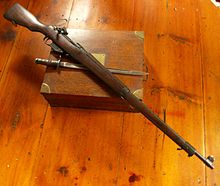| Ross rifle | |
|---|---|
 | |
| Type | Bolt action rifle |
| Place of origin | Canada |
| Service history | |
| In service | 1905–1918 1939–1945 |
| Used by | See Users |
| Wars | World War I Irish War of Independence Spanish Civil War World War II 1947–1949 Palestine war |
| Production history | |
| Designer | Charles Ross |
| Designed | 1903 |
| Produced | 1903–1918 |
| No. built | 420,000 |
| Variants | Mark I (1903) Mark II (1905) Mark II .280 (1907) Mark III (1910) Mark IIIB (1914) Huot Automatic Rifle (1916) |
| Specifications | |
| Mass | 3.9 kg (8.6 lb) |
| Length | 1,320 mm (52 in) |
| Barrel length | 711 mm (28.0 in) (Mk 1 and Mk IIs) 774 mm (30.5 in) Mk II** and Mk III) |
| Cartridge | .303 British (7.70×56 mm R) |
| Caliber | .303 in (7.70 mm) |
| Action | Straight-pull bolt action |
| Rate of fire | User dependent |
| Feed system | 5-round stripper clip/charger |
The Ross rifle is a straight-pull bolt action rifle chambered in .303 British that was produced in Canada from 1903 until 1918.[1]
The Ross Mk.II (or "model 1905") rifle was highly successful in target shooting before World War I, but the close chamber tolerances, lack of primary extraction and length made the Mk.III (or "1910") Ross rifle unsuitable for the conditions of trench warfare, exacerbated by the often poor quality ammunition issued.[2]
By 1916, the rifle had been withdrawn from front line service but continued to be used by many snipers of the Canadian Expeditionary Force until the end of the war due to its exceptional accuracy.[3][page needed]
The Ross Rifle Co. made sporting rifles from early in its production, most notably chambered in .280 Ross, introduced in 1907. This cartridge is recorded as the first to achieve over 3,000 ft/s (914 m/s) muzzle velocity and the cartridge acquired a very considerable[clarification needed] international reputation among target shooters and hunters.[1][page needed]
- ^ a b Phillips, Roger Francis; Dupius, Francis & Chadwick, John (2002). The Ross Rifle Story. Toronto: Michael W. Leonard. ISBN 978-0-973241600.
- ^ Duguid, Archer Fortescue (2001) [1938]. Law, Clive M. (ed.). A Question of Confidence: The Ross Rifle in the Trenches. Ottawa: Service Publications. ISBN 978-1-894581004.[page needed]
- ^ Law, Clive M. (2004). Without Warning: Canadian Sniper Equipment in the 20th Century. Ottawa: Service Publications. ISBN 978-1-894581165.